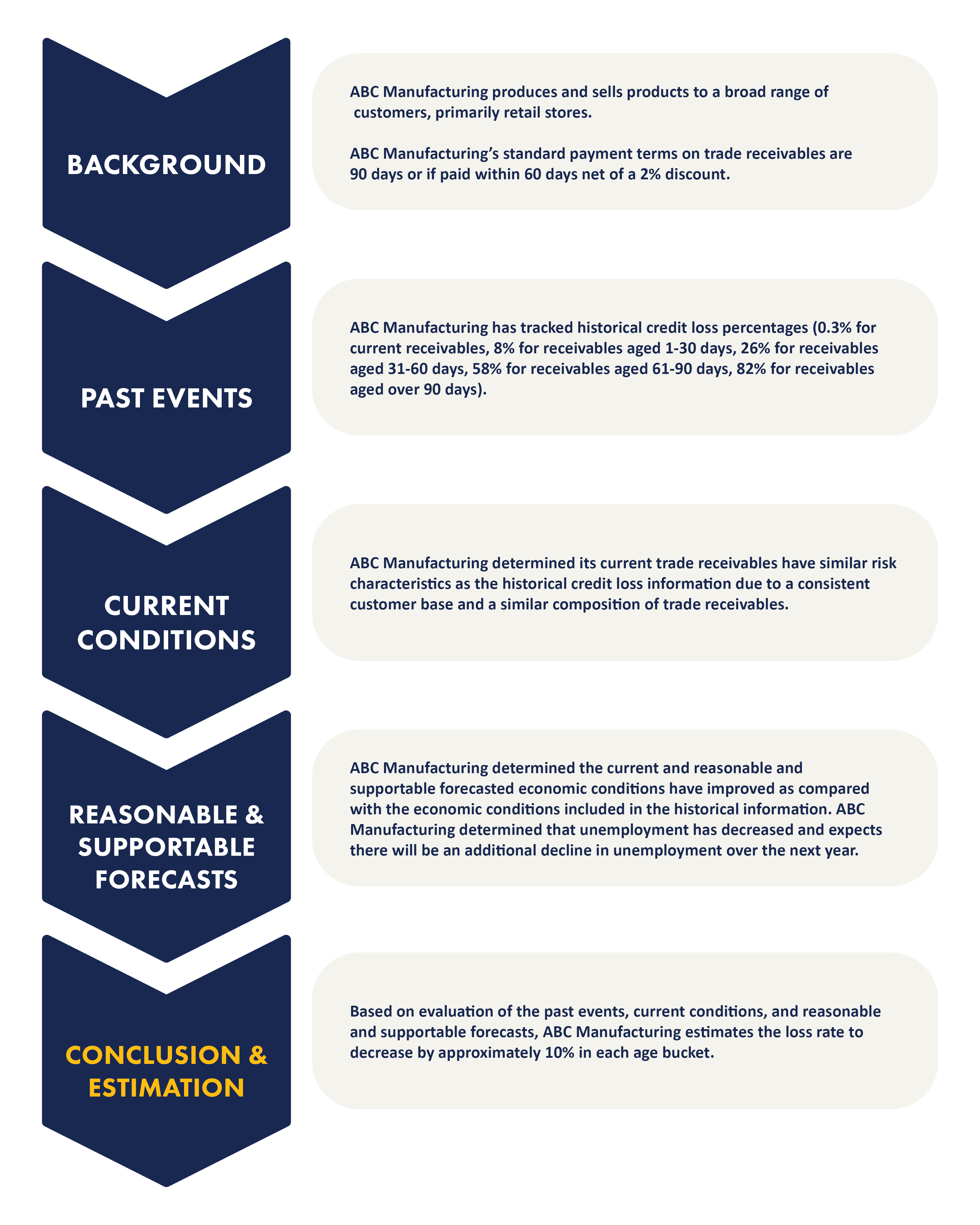Make sense of the CECL standard and what it means for your organization.

The new CECL standard impacts far more than just financial institutions. The objective of Accounting Standards Codification (ASC) Topic 326, Financial Instruments – Credit Losses is to provide financial statement users with more decision-useful information about expected credit losses on financial instruments. ASC 326 shifts from the incurred loss model to the current expected credit loss model (more commonly referred to as CECL). Since trade accounts receivable are among the items impacted by the new standard, many entities will need to understand these changes to determine how to record these assets going forward.
Current generally accepted accounting principles (GAAP) require entities to evaluate potential credit losses using an incurred loss model. This means entities would not recognize credit losses until it is probable that a loss has been incurred. After applying CECL, entity’s affected financial assets will reflect the amount of expected credit losses that are expected to occur over the contractual life of the financial assets.
- The expected credit loss model does not apply to available-for-sale (AFS) debt securities, but ASC 326 does modify how entities measure AFS debt securities for impairment. Learn more about what to expect when you have available sale debt securities.
Here are four steps to take when implementing the new CECL standard.
Step 1: Identify Potentially Impacted Assets
Does your organization have any of the following?
- Financial assets measured at amortized cost.
- Trade receivables (receivables from revenue contracts)
- Loans or notes receivable (that are considered financing receivables)
- Held-to-maturity debt securities
- Net investments in leases recognized by a lessor such as lease receivables from sales-type or direct financing leases.
- Off-balance-sheet credit exposures not accounted for as insurance or derivatives such as financial guarantees, loan commitments, or standby letters of credit.
- Reinsurance receivables.
- Any other financial assets not excluded from the scope that have the contractual right to receive cash.
Step 2: Select Method(s) for Measuring Expected Credit Losses
ASC 326 doesn’t require a particular model/method to be used in measuring expected credit losses. It provides general guidelines and examples, but otherwise leaves the selection of a model/method to the entity’s judgment. Entities will need to evaluate which method(s) are best to develop reasonable and supportable forecasts.
Examples of potential measurement models include:
- Aging schedule analysis: Expected credit losses are determined on the basis of how long a receivable has been outstanding (e.g., under 30 days, 31-60 days). This method is commonly used in the allowance on trade receivables.
- Discounted cash flows (DCF) method: Expected credit losses are determined by comparing the asset’s amortized cost with the present value of the estimated future principal and interest cash flows.
- Loss-rate method: Expected credit losses are determined by applying an estimated loss rate to the assets amortized cost basis.
- Probability of default method: Expected credit losses are determined by multiplying the probability of default by the loss given default.
- Rate-roll method: Expected credit losses are determined by using historical trends in credit quality indicators (e.g., delinquency, risk ratings).
- Regression analysis: Statistical based modeling approach.
Step 3: Gather Data and Estimate Expected Credit Losses
The asset will now be presented at the net amount the entity expects to collect on the asset, with an allowance for credit loss for the difference between the amortized cost and the expected collection amount. The allowance for credit loss will be subsequently increased/decreased as the expected amount to be collected changes.
In addition to past events, historical experience, and current conditions, the measurement of expected credit losses will now also include a reasonable and supportable forecast of collectability.
In evaluating the relevant information, entities must use judgement to ensure their estimation methods are appropriate in the circumstances.
Below is an example of how to estimate credit losses using an aging schedule:
Aging Schedule Example – Estimating Credit Losses for Trade Receivables Example
(Adapted from Example 5 in ASC 326)

ABC Manufacturing Estimated Expected Credit Loss on Trade Receivables
| Trade Receivable Aging Buckets | Amortized Cost Basis | Historic Credit Loss Rate | Adjustment | Expected Credit Loss Rate | Expected Credit Loss Estimate |
|---|---|---|---|---|---|
| Current | $6,000,000 | 0.30% | -10% | 0.27% | $16,200 |
| 1-30 days past due | $500,000 | 8.00% | -10% | 7.20% | $36,000 |
| 31-60 days past due | $100,000 | 26.00% | -10% | 23.40% | $23,400 |
| 61-90 days past due | $50,000 | 58.00% | -10% | 52.20% | $26,100 |
| Over 90 days past due | $15,000 | 82.00% | -10% | 73.80% | $11,070 |
| $6,665,000 | $112,770 |
Step 4: Evaluate Impact on Presentation and Disclosure of the Financial Statements
It’s also important to understand key changes in balance sheet presentation. You’ll now refer to allowance for credit losses instead of allowance for doubtful accounts. In addition, the allowance for credit losses that is deducted from the asset’s amortized cost basis is required to be separately presented on the balance sheet.
ASC 326 also requires expanded disclosures related to credit losses with the intent of enabling financial statement users to understand:
- The credit risk inherent in a portfolio and how management monitors the credit quality of the portfolio.
- Management's estimate of expected credit losses.
- Changes in the estimate of expected credit losses that have taken place during the period.
Finally, look for key changes in footnote disclosures. ASC 326 requires expanded disclosures related to the following:
- Credit quality information.
- Allowance for credit losses (including a qualitative roll forward of the allowance for credit losses from the beginning balance of the allowance for credit losses to the ending balance of the allowance for credit losses).
- Past-due status.
- Non-accrual status.
- Purchased financial assets with credit deterioration.
- Collateral-dependent financial assets.
- Off-balance-sheet credit exposures.
The Impact of CECL on Non-Financial Institutions
CECL has been discussed for a while in the banking world. However, the standard has broader implications for a variety of organizations. It’s important to understand how this new standard may impact your organization.

